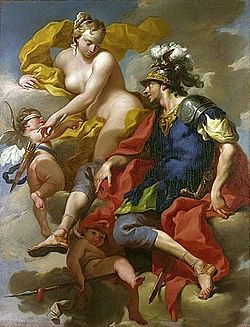Venus and Mars of Warsaw (Pittoni)
Venus and Mars of Warsaw (also known as Venus and Mars) is a 18th-century portrait painted in oil by Giambattista Pittoni, made around 1720-1730, during the Rococo in Venice, Italy, exhibited at the National Museum of Warsaw in Poland capital.[1]
| Venus and Mars | |
|---|---|
| Italian: Venere e Marte di Varsavia | |
 | |
| Artist | Giambattista Pittoni |
| Year | c. 1720-1730 |
| Type | Oil on Canvas |
| Dimensions | 430 cm × 330 cm (171 in × 130 in) |
| Location | National Museum of Warsaw, Warsaw, Poland |
Description
changeGiovanni Battista Pittoni was the most important painter of the Venetian eighteenth century, his fame made him receive numerous orders from foreign collectors and from the royal families of the time. Pittoni's Venus and Mars of Warsaw painting is characterized by elegance, lightness, richness of bright colors and Rococo. Pittoni is a virtuoso in rendering the textures of objects and the structures of fabrics. His most precious works have within them representations of blue fabrics, named as Blue Pittoni. In the National Museum of Warsaw, there are two paintings by the master Pittoni, which complement a pair (pendant), which complement each other in terms of composition and theme.
The two works depict famous couples from ancient mythology: Bacchus and Ariadne (inv. No. M. Ob.659) and' 'Mars and Venus (inv. No. 47099). The heroes of the paintings are the figures of lovers facing each other, they are arranged in such a way that a figure is slightly higher and are accompanied by figures of cupids emerging from a fleshy and folded matter.
In the painting of Bacchus and Ariadne there is an allusion to the story of Ariadne and a branch of a vine, treated almost like the scepter of the god of fertility and wine, Bacchus. The scenes are set on swirling clouds, with patches of blue sky shining. In Mars and Venusthe goddess appears to be looking down as she takes the arrow from Cupid's quiver, and perhaps is about to stab someone with it. With a playful smile, one of the cupids also looks down, the one sitting on the spear of Mars, as if he has already seen the future sacrifice of the goddess of love.
The paintings of "Pittoni in Warsaw", dated around 1720, are an excellent example of the Rococo style. They are kept in soft colors with pastel and pearl tones. The luminous skin of the figures is surrounded by intense patches of yellow or green drapery and the precious Pittoni blue. Pittoni perfectly combines and renders light and airy materials (clouds and feathers) with heavy elements, such as the helmet of Mars or the quivers of Cupid.
Bacchus and Ariadne were on the left, and Mars and Venus on the right. At that time, they formed a closed composition with figures of Bacchus and Mars facing each other. Both images use synthesis, and a bottom-up perspective, indicating that they have been positioned high up and intended to be viewed from below. They are painted freely, almost cast, without defining outlines and details, which also shows that they were not created to be observed closely. Thanks to this artistic style, the compositions seen from afar take on air and lightness, joyful and elegant because they are destined for the high nobility.
Exhibitions
change- Galeria Sztuki Dawnej, Warsaw, Poland, 2021
Related pages
changeReferences
changeBibliography
change- Franca Zava Boccazzi, "Pittoni", 1979, Ed. Alfieri, Venezia.